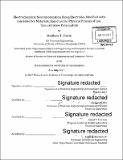| dc.contributor.advisor | Jongyoon Han and Daniel K. Freeman. | en_US |
| dc.contributor.author | Flavin, Matthew T | en_US |
| dc.contributor.other | Massachusetts Institute of Technology. Department of Electrical Engineering and Computer Science. | en_US |
| dc.date.accessioned | 2017-12-05T19:12:23Z | |
| dc.date.available | 2017-12-05T19:12:23Z | |
| dc.date.copyright | 2017 | en_US |
| dc.date.issued | 2017 | en_US |
| dc.identifier.uri | http://hdl.handle.net/1721.1/112428 | |
| dc.description | Thesis: S.M., Massachusetts Institute of Technology, Department of Electrical Engineering and Computer Science, 2017. | en_US |
| dc.description | Cataloged from PDF version of thesis. | en_US |
| dc.description | Includes bibliographical references (pages 96-107). | en_US |
| dc.description.abstract | Developing precise and effective means of modulating the human nervous system is an aspiration of the fields of neuroscience and neurotechnology. Our research group is approaching this challenge by constructing a prosthetic device that can perform focal chemical modulation of selected ions in the interstitial space of neural tissue. Its principle of operation is based on ion-concentration polarization (ICP) generated by polarization of electrodes covered with ion-selective membranes (ISMs). In order to optimize this modality in terms of clinical effect and safety, we require a more fundamental understanding of the physical processes that give rise to ICP of the selected ion. Broadly, the goal of this thesis is to: (1) present and validate mathematical models for the description and prediction of polarized ISM systems, and (2) characterize transport phenomena that are uniquely captured using these models. To start, we used a semi-empirical equilibrium model to compare the integral transference of several common membrane formulations in a physiological electrolyte. Then, we introduced a 1-D model of Nernst-Planck-Poisson (NPP) with kinetic ion-ionophore reaction that could be solved using the finite element method (FEM). Our analysis of this model focused on four key features: the interfacial transition regions at the contact planes between the aqueous and membrane phases, the intra-membrane reaction boundary layer (RBL), ICP arising in the aqueous phase, and ICP arising in the membrane phase. Lastly, we presented several multidimensional models of ion transport in the aqueous phase. This was used to examine processes that limit the lengthscale of aqueous ICP, such as forced convection and non-planar diffusion. Once fully realized, an ISM-based device could be used to manipulate extracellular ions in neural tissue to produce therapeutic effects. In the peripheral nervous system, this operation could potentially be used to lower the stimulus energy required to elicit muscle activation (via Ca 2 depletion), or block aberrantly firing nerves that characterize neuropathic pain disorders (via either K+ depletion or enhancement). Eventually, ISM-based stimulation could be applied to the central nervous system to address neurological and psychiatric disorders. | en_US |
| dc.description.statementofresponsibility | by Matthew T. Flavin. | en_US |
| dc.format.extent | 107 pages | en_US |
| dc.language.iso | eng | en_US |
| dc.publisher | Massachusetts Institute of Technology | en_US |
| dc.rights | MIT theses are protected by copyright. They may be viewed, downloaded, or printed from this source but further reproduction or distribution in any format is prohibited without written permission. | en_US |
| dc.rights.uri | http://dspace.mit.edu/handle/1721.1/7582 | en_US |
| dc.subject | Electrical Engineering and Computer Science. | en_US |
| dc.title | Electrochemical neuromodulation using electrodes modified with ion-selective materials, based on the physical process of ion-concentration polarization | en_US |
| dc.title.alternative | Electrochemical neuromodulation using electrodes modified with ISMs, based on the physical process of ICP | en_US |
| dc.type | Thesis | en_US |
| dc.description.degree | S.M. | en_US |
| dc.contributor.department | Massachusetts Institute of Technology. Department of Electrical Engineering and Computer Science | |
| dc.identifier.oclc | 1008758635 | en_US |
